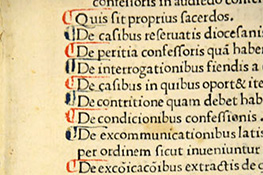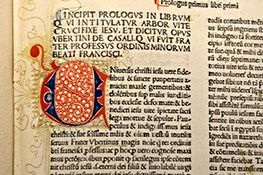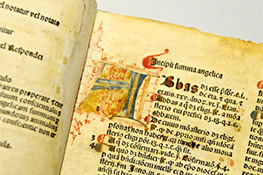Versione italiana English version Version française Versión en español
The Giuseppe Grosso Library holds among its treasures 11 incunabula, which can be consulted and downloaded in their entirety on:
- https://archive.org/details/@giuseppe_grosso_library?tab=uploads&and[]=subject%3A%22Historical+prints%22&and[]=subject%3A%22Incunabula%22&and[]=mediatype%3A%22texts%22
- https://commons.wikimedia.org/w/index.php?search=media+from+giuseppe+grosso+library&title=Special:MediaSearch&go=Vai&type=image
Below is the list of the 11 works with links to digital copies.
- Decreta sabaudiae ducalia tam vetera quam nova
It is a gathering of statutes from Piedmont printed in 1477 by Pietro Cara, one of the first representatives of humanism in Piedmont, he was born in San Germano Vercellese in 1440. The incunabulum, that is all rubricated in red, has the drop caps finely drawn and handed watercolored.
According to the expert Ada Peyrot it is the "edition princeps" printed in the Giovanni Fabri's Turin officine who, born in Borgogne, introduced the art of printing in Turin and in other minor centers in Piedmont.Decored with hand refined drop caps, with splendid round printings, it is the first printed edition of a gathering of statutes belonging to a nation. From a legal point of view it contains the rules of well governance, ones emitted by Amedeo VIII in 1430 with additions by Duke Filiberto and his regent mother Duchess Jolanda di Savoia.
- Summa confessionum. Incipiunt rubrice super tractatum de instructione seu directione simplicium confessorum...
It is the first dated book printed in Piedmont, in Mondovì, by Antonio Mattia (Antonio Mathias of Anversa) and Baldassarre Cordero, the 24th of October 1472. It is one of San Antonino's most important works. The saint, from Florence (1389-1459), is considered to be one of the most important people from Rinascimento Church because of the support he gave to Beato Angelico's work and to have founded, first in Europe, a public library. The book, whose cap drops spaces are all rubricated in red and blue, contains the text of the "Confessional" without other additions nor comments.
- Manipulus Curatorum.
Written by the theologist Guido de Monte Rocher, it is the first book printed in Piedmont, in Savigliano, by Cristoforo Beggiamo and Johan Glim. The bibliophiles agree dating it around 1470. The initials are painted in red and blue and there are coeval handwritten side notes. It is a fundamental step in Piedmont civilization history. It is a religious vademecum about mass and sacraments.
- Lectura super Clementinis.
It is the fifth edition of the comment on Decretales by pope Clemente V made by cardinal Franciscus de Zabarellis (1360-1417). Pope Clemente V (born Bertrand de Got, 1264-1314) went down in history for suppressing the order of the Templars and for moving the Holy See to Avignone. The volume, printed in Turin the 23rd of August 1492 by Nicolaus de Benedictis and Jacobinus Suigus, is constituted by a big "in-folio" in a coeval holding with wooden shingles.
Inside the anterior flat there is a reinforcement with a handwritten fragment in Carolina lowercase of IX century (hand writing style from Carolingian era). The printer, from San Germano Vercellese, introduced the art of printing in his native village in 1484, in Vercelli in 1485 and in Chivasso in 1486. He went then to Turin creating a small society with Nicolò Benedetti, operating from 1489 to 1498.
- Satyrae
The volume contains the sixteen satire by Giovenale commented by two of the most famous humanists, Domizio Calderino and Giorgio Valla, with the notes of the grammarian Valerius Probus, discovered by Valla himself who incorporated them in his comment. It is the first book with greek letters printed in Turin, by Nicolaus de Benedictis and Jacobinus Suigus, the 8th of October 1494. During ‘400 only few printers, outside Venice, could dispose of a greek letters set. The book has a beautiful coeval binding with the original flats in wooden shingles. Also by the point of view of the topic, it is a rarity between incunabula, that generally deal about religious or legal subjects.
- Arbor vitae crucifixae Jesu
Voluminous treaty by Ubertino da Casale who deals with the life and the passion of Christ. The concept of the opera can be found in the "Lignum Vitae" by San Bonaventura, where can be found the same image of the history tree, whose roots deep in the world origins, until Christ' s incarnation. Its branches are Christ's actions, the flowers and the fruits are the acts of the elected.
The "Arbor Vitae" constitutes the most relevant work by Ubertino (1259-1330), preacher and theologist from Franciscan order, intricate figure, more than once excommunicated, died murdered, at least according to the Fraticelli, heirs of the Spirituali. In his treaty, Ubertino shows an apocalyptic vision of the Church history, inspired by the premonitions of Gioacchino da Fiore, waiting for a peace period under the guide of an "angelic pope" who would have restored its authority, lost because of the bad behaving of the recent pastors. As a curiosity, we remember that Ubertino is one of the main characters from "Il nome della Rosa" by Umberto Eco, shown as a friend of the imaginary protagonist Guglielmo di Baskerville.The precious incunabulum printed in Venice by Andrea de Bonettis de Papia in 1485 has side notes, beautiful historiated drop caps and a wonderful imprint.
- Summa angelica
The only book printed in Chivasso in Xv century by Suigus, it is a moral theologic treaty, written by Franciscan friar Angelo Carletti, blessed patron of Chivasso (1411-1495). The volume deals with the various issues of conscience and it is supposed to be a guide for confessors, it was a great success and had a great spread, as a symbol of the catholic orthodoxy it was burned by Luther on the public square of Wittenberg the 10th of December 1520, with the bull of excommunication, the code of canon law, and the "Summa Teologica" by San Thomas. The incunabulum is dated 1486, it has many side notes and the drop caps in red and blue duotone.
- Decreta Ducalia Sabaudiae
- Quadragesimale doctoris illuminati Francisci De Mayronis
- Sermones quadragesimales fratris Antonij de Vercellis ordinis minoru de observantia
- Sermones Quadragesimales fratris Antonii de vercellis de XII mirabilibus christiane fidei excellentis







